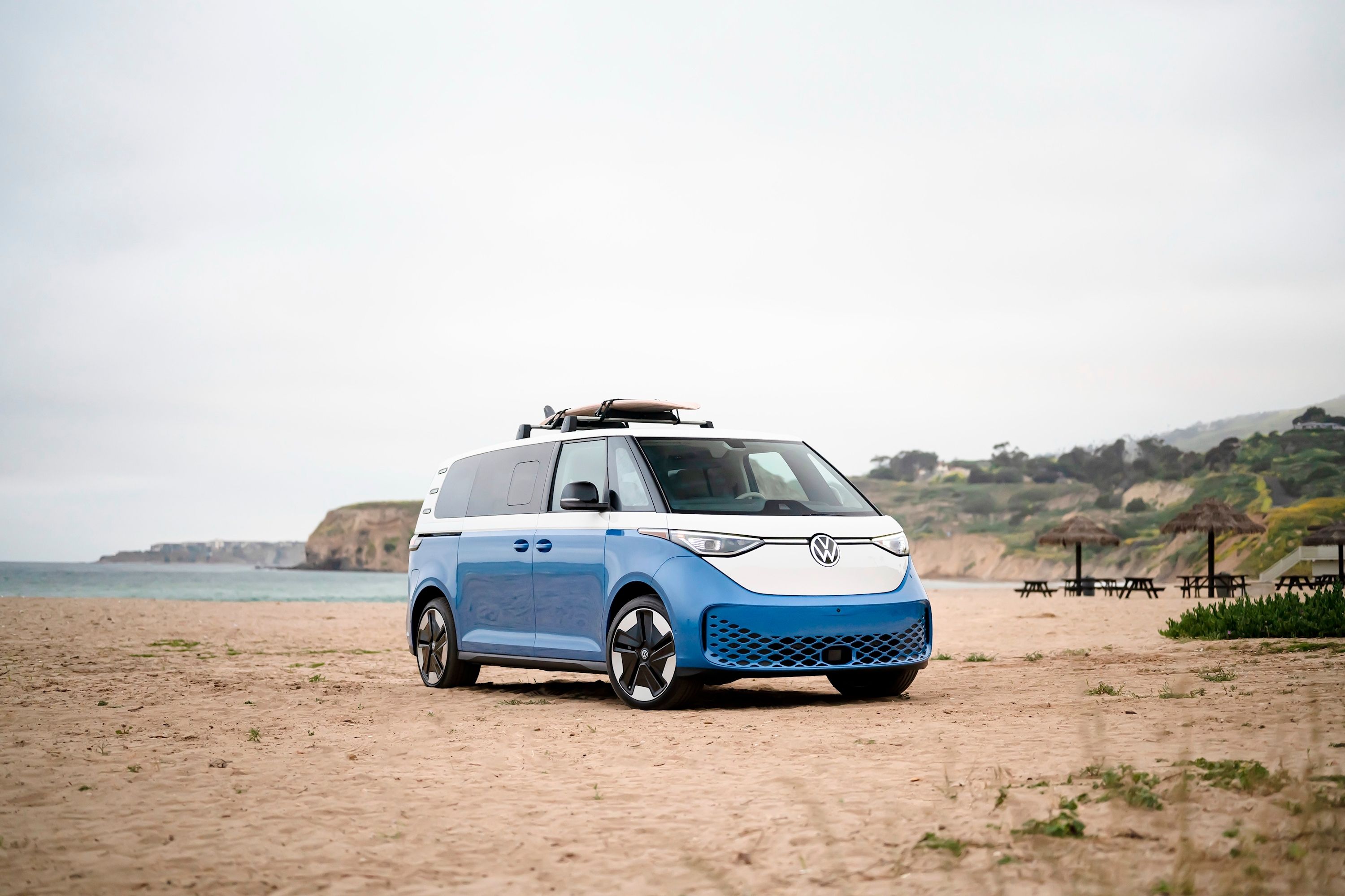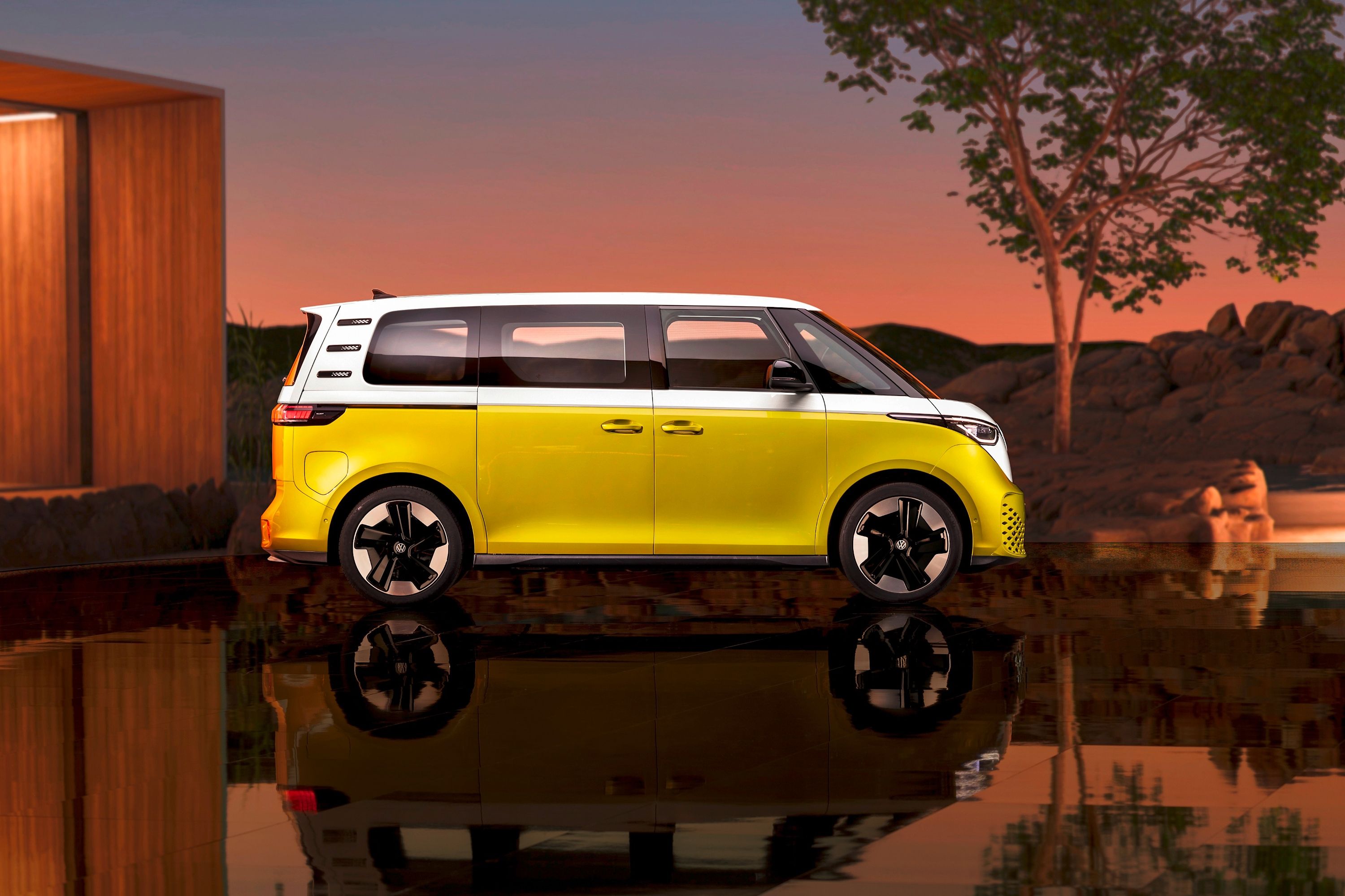
The Volkswagen ID.Buzz has been making VW fans salivate since we first saw a concept at Detroit in 2017, which feels like a lifetime ago. But with leaked images and plenty of exciting teasers in recent months proving that this will be a bit more than just an electric Transporter van, it seems that the half-decade wait has been worthwhile. Now, the time has finally come to show the production version to the world, and it's a stunner. While we know that more enthusiast-focused EVs will come in time, this latest release is perfect for both the nostalgic, diehard VW fan and the pragmatic business owner. How so? Let's take a look at the dimensions, features, and design cues to see how that statement rings true.
Unfortunately, the details we're about to unpack are specific to the European market, but Volkswagen promises to reveal the details of the US version closer to launch. As with other ID. vehicles, the ID.Buzz is based on the Volkswagen Group's Modular Electric Drive Kit (MEB), the world's first scalable large-production-run platform. Thus far, 30% of the Group's vehicles run on this platform, but VW wants to use the ID.Buzz to help increase that number to over 80% by 2025. But enough about the manufacturer's plans; what does the MEB platform provide the new electric bus with, and is there enough power and torque to make this a comfortable family car and a viable commercial vehicle?
The first European versions of both the ID.Buzz and the ID.Buzz Cargo commercial vehicle get a floor-mounted, high-voltage, lithium-ion battery providing a gross energy rating of 82 kilowatt-hours (77 kWh net). The result of this 12-module battery system is a claimed 201 horsepower and 229 lb-ft of torque, all of which goes to the rear axle. Acceleration figures aren't all that important, but we are interested in the electronic speed limit of 90 mph, which is plenty for a family or commercial vehicle, although we do wonder how badly that figure would suffer when the bus is fully laden. Regardless, "more battery versions with various power output levels are expected to follow in 2023," says Volkswagen.
Thanks to its low placement in the body, the battery helps contribute to a low center of gravity, thus promising agile handling for a vehicle of this size. As for charging capacities, you get 11 kW on alternating current and up to 170 kW via a CCS plug connector at a DC fast-charging station. Using the latter method, the battery can be charged from 5-80% in as little as 30 minutes. In the future, the Plug & Charge function as seen on the Porsche Taycan will also be added here via software updates. In Europe, bi-directional charging (like the vehicle-to-load system seen on the Ford F-150 Lightning) will enable home power stabilization through an optional DC bi-directional wall box.
Right, let's get on with the design. Both variants are 185.5 inches long and 78.1 inches wide with a wheelbase of 117.6 inches, but the US version will be based on a long-wheelbase model. For now, the two existing Buzz variants differ in height, with the regular version measured at 76.3 inches high and the cargo version just one millimeter taller due to slight differences in the chassis. Thanks to short overhangs, the vehicle looks great and offers loads of interior space, as well as a relatively small turning circle of just 36.4 feet. Combined with that low center of gravity, this looks like it could be relatively fun to drive.
Practically speaking, it has been designed well, with the front seats able to move 9.6 inches fore and aft and 2.4 inches in height. In the rear, a three-person bench can be folded down or in a 40:60 split, and it can also be moved lengthways a total of 5.9 inches. An optional height-adjustable trunk floor is offered too, while two side sliding doors improve ingress, egress, and loading. A total of 39.6 cubes of luggage space are available. In the Cargo variant, 137.7 cubic feet are available, with lashing rings further bolstering practicality. This model only gets one sliding side door as standard, but a second can be optionally added. The standard-length vehicle launches with five seats, but six- and seven-seater options are coming.
Speaking on the retro styling that we think is a great balance of nostalgia and forward thinking, Head of Volkswagen Design Jozef Kaban says that, although the iconic T1 bus of the 1950s inspired designers, it didn't dictate the look of the new bus: "We very consciously ensured that we were not making another T1. The ID. Buzz shows that it is successfully transferring the genes and stylistic elements of that iconic vehicle into the digital era."
This is clearly apparent in the short overhangs, maximization of space despite a small footprint, the split bodywork, the V-shaped "hood" design, and the unique rear that includes a pillar with perfectly placed triple accents on each side of the profile. The horizontal LED taillights are connected by a full-width light strip for the first time on a Volkswagen Commerical Vehicles model, and the front gets similar treatment. We're especially loving the subtle nod that is the oversized front VW badge, the biggest on any current Volkswagen, electric or otherwise.
In total, 11 color combinations are offered, with seven single-color options: Candy White, Mono Silver, Lime Yellow, Starlight Blue, Energetic Orange, Bay Leaf Green, and Deep Black. Four two-tone options are listed as follows, with each getting an upper section and "hood" in contrasting Candy White: Lime Yellow, Starlight Blue, Energetic Orange, and Bay Leaf Green. Both Euro versions will get 18-inch wheels as standard, but passenger vehicle models will have access to alloys from 18-20 inches in diameter.
Inside, 10-color ambient lighting is standard with a 30-color system optional. The latter lights up a strip in the instrument panel, the strips in the doors, and the storage bins in the doors and footwell. The 10-inch Digital Cockpit (a 12-inch screen with navigation is optional) and 10-inch infotainment display will match the chosen color, and various combinations can be created or perused via the 'Mood Menu.' Dual-zone climate control and adjustable front inner armrests are provided, with memory and massage functions, as well as adjustable outer armrests, among the options.
The base interior in Europe is called Soul, but four Mistral interior trim options are available for the five-seater too, with these boasting two-tone finishes as seen on the exterior. Candy White is used on the instrument panel, the door trim accents, the outer panels and backs of the seats, and even the steering, although this last cue is an option. X Blue, Orange, Yellow, or Green can be found in the dash, the upper door insert sections, and the inner seat panels.
All models also come with ID.Light - a clever system that uses directional colored lighting to indicate danger, navigation directions, and other information. We saw this on the ID.4 and, although it may sound cheap, it's a remarkably effective way of indicating information to the driver without averting their gaze away from the road. All ID. models will make use of this feature, but we wouldn't be surprised if it becomes common on some traditional cars too.
In regards to safety, Euro models will get Front Assist, Lane Assist, and Dynamic Road Sign Display as standard, while options will include Side Assist, Travel Assist, Emergency Assist, Park Assist, Light Assist, Area View, and adaptive cruise control. That's a lot of assistance.
The vehicle is "safe" for the environment too, with the battery free of cobalt and the cabin free of leather. The steering wheel cover is made of polyurethane, "but looks just as high quality as leather and provides a similar feel." The seat covers, floor coverings, and roof liner are made from recycled material and, in the future, a fabric called Seaqual yarn, with fibers made of 10% collected ocean plastic and 90% recycled PET bottles, will be available too.
Volkswagen's efforts to improve its environmental image extend to a manufacturing plant that recycles the batteries at the end of their life cycles to prepare them for a second use. As with other EVs, a typical 100,000-mile/eight-year warranty is provided.
European production begins in the first half of this year, with initial launches beginning in the third quarter. The start of advance sales in Europe begins in May, while the North American debut of the long wheelbase happens in 2023 with sales starting in 2024. Hopefully, we'll have range figures before then, but for now, we're just loving the design and can't wait to take a closer look at the movable and removable center console, as well as the stylized silhouettes embossed into the luggage compartment and seat sides.
Will this become an icon like the vehicle that inspired it? Time will tell, but VW certainly wins points for not straying much from the concept. The five-year wait is finally over, and the result is sure to be a crowd favorite.

